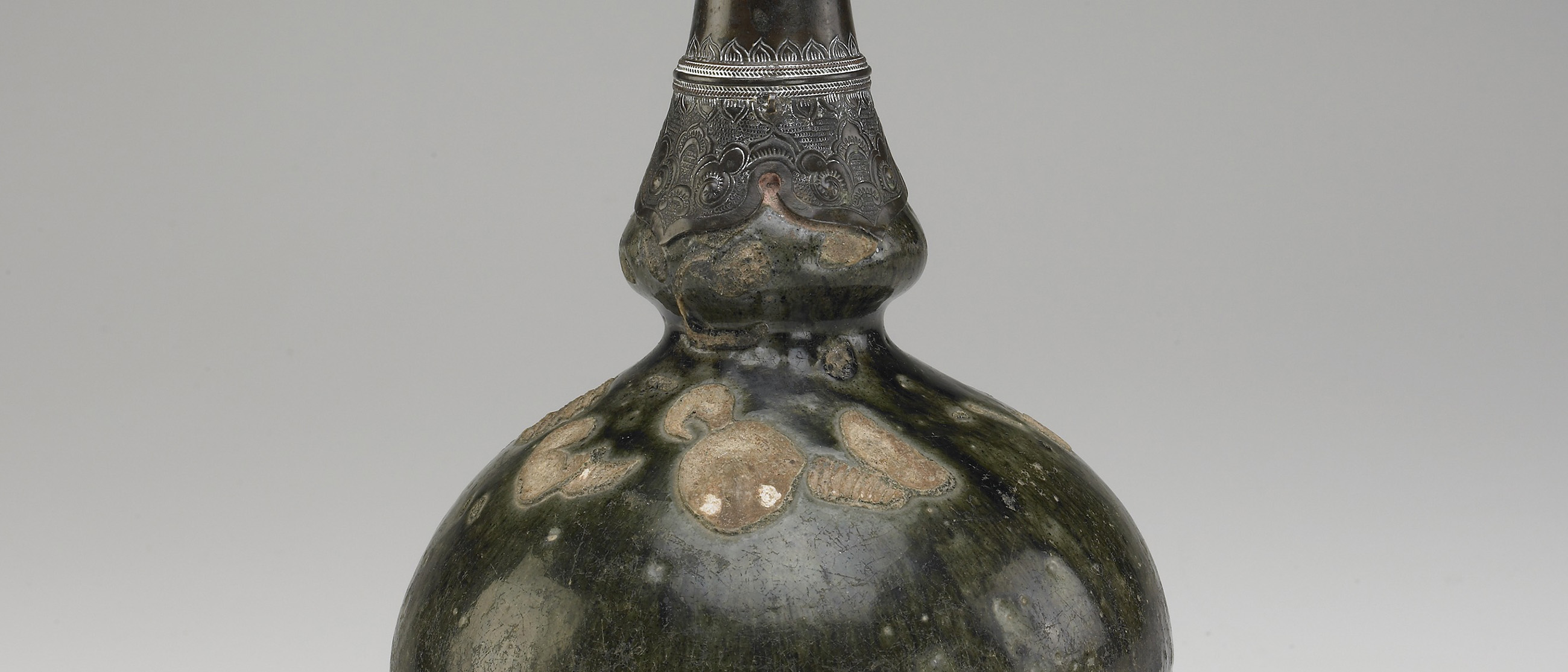Surfaces
In the final stage of preparing a ceramic vessel for firing, or at the conclusion of firing, a variety of procedures may be chosen to improve and enhance its surface. Ceramics in Mainland Southeast Asia manifest an array of surface treatments. One choice is to do nothing at all—and plain earthenware and unglazed stoneware are both venerable traditions. Some earthenware has been transformed after firing either by smoking or by applying a dark resin coating. Many stonewares (and some earthenwares) have been finished by glazing.
As defined by materials scientist Pamela Vandiver, “A glaze is the glassy coating that seals and adorns the surface of a ceramic body” (Vandiver 1990, 106). Both practicality and aesthetics motivated potters to develop and apply glazes to ceramics. Chemical analysis shows that glazes are composed of alumina, silica, and fluxes (impurities consisting of various metallic oxides). Each of these components has a function: Alumina provides the “bones” of a glaze, silica forms a glass, and fluxes lower the temperature at which the glaze melts. In addition, metallic oxides, whether occurring naturally in the glaze materials or incorporated intentionally, add color. The color and texture of a glaze as we perceive it depend upon the interactions of light with the glaze’s surface, substance, and substructure. Especially when a glaze is well melted and transparent, the color of the clay body beneath the glaze affects the color we see (Vandiver 1990).
Whereas a modern potter might purchase industrially prepared raw materials and mix them to the precise proportions indicated in a glaze recipe, potters in the past achieved the approximate formulation by mixing locally obtained raw materials, such as wood ash collected from the kiln or hearth and iron-bearing clay dug from beneath the rice paddy. They learned by trial and error how to mix these ingredients by proportion—one scoop of this to every two scoops of that—to achieve a satisfactory result. A greenish tonality resulted from a small percentage of iron naturally occurring in the raw materials. More intense colors, ranging from stronger green to golden brown to brownish black, could be achieved by adding the appropriate amount of iron-bearing clay.
Beginning during the late Angkor period and continuing at kilns in Sawankhalok (Hein 2001, 74) and Lan Na, potters in Mainland Southeast Asia enjoyed combining two colors of glaze—green and brown—on a single vessel. Late Angkorian potters also painted brown slip under portions of green-glazed vessels to create a two-color effect. Potters in North Vietnam cultivated a technique of two-toned “glaze inlay” by scraping away design areas of the overall ivory-toned glaze coating and painting in with iron-brown glaze. During the twelfth through fourteenth centuries, they also made small vessels—bowls and ewers—that were glazed ivory or pale green on the inside and brown on the outside.
High-temperature glazes for stoneware were almost always applied to raw or green (not yet fired) pots. There is little or no evidence, before recent times, of the use of a system by which pots were first fired to a moderate (“bisque”) temperature, then glazed and refired to a temperature to harden the pot and melt the glaze. (Whether firing glazed or unglazed pots, potters learned to anticipate the correct temperature by observing the color of the flame and the surface of the vessels in the kiln, with the occasional assistance of small test pieces pulled from the kiln in the course of firing.)
Close observation of a pot can reveal how the glaze was applied. In some Lan Na kilns, including San Kamphaeng and San Sai, iron glaze was applied to jars and large basins using a soft brush swabbed horizontally around the vessel. Often the vessel rested upside down on its mouth rim—the drips of extra glaze run toward the mouth. At the Maenam Noi kilns, potters followed the procedure seen on contemporaneous southern Chinese jars and ladled the glaze onto the pot, making sure it ended well above the foot in order to avoid problems of running and sticking during firing. Sometimes excess glaze was wiped away from the lower portion of the jar. For a more finished appearance, dishes and bowls made at kilns in North Vietnam and elsewhere were first glazed overall, then the glaze was trimmed away from the foot rim.
Lead glaze was used infrequently in Mainland Southeast Asia. A West Asian source is proposed for the opaque white tin-opacified lead glaze used on earthenware made in Lower Burma at a still-unidentified site (Di Crocco and Shulz 1985). The impact of Chinese enamel-decorated porcelain can be seen in the use of lead-silicate enamels at Red River Delta kilns (notably My Xa) in North Vietnam to decorate stoneware over the glaze. The copper-green lead glaze used on vessels from the Zhangzhou kilns in Fujian may have been the source of inspiration (and perhaps directly-transmitted technology) for the copper-green glaze used briefly in the Tung Man group within the Kalong kilns (Shaw 1987, 59 and 71).

